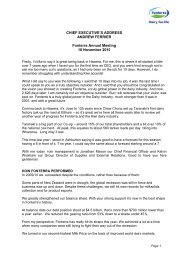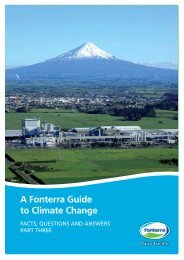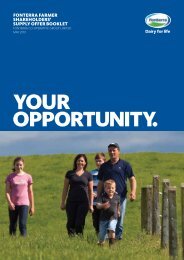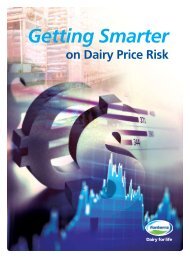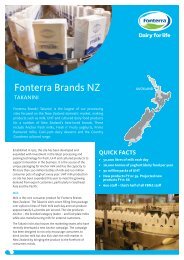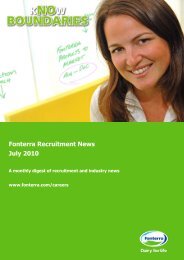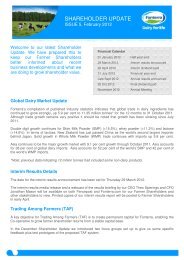Create successful ePaper yourself
Turn your PDF publications into a flip-book with our unique Google optimized e-Paper software.
5 Major Issues IdentifiedA summary of the major issues identified by the Committee’sadvisors, together with the status of those issues, is set out below.The issues have been grouped under each of the due diligencework streams.5.1 Co-operative Model<strong>Report</strong>s from Professor Cook and PwC highlighted a number ofissues experienced by other co-operatives that had undertakencapital structure changes. While the TAF structure differs fromall those in the comparative sample, some learnings can be takenfrom them. In particular, the reports discussed examples wherethe rights of external investors invited to invest in a co-operativewere subsequently expanded beyond those originally envisaged.However, in many situations such examples were the result of acombination of factors not purely related to the capital structurechange, including major changes in strategy, aggressive use ofleverage, and poor governance.While TAF is unique, relevant observations from these reports tohelp minimise the prospect that farmer control is put at risk werethe need to maintain:i. The Fund size as low as practically possible to minimiseany exposure to the potential conflict between FarmgateMilk Price and profits, and to ensure <strong>Fonterra</strong>’s ability tobuyout the Fund if it does not perform as intended;ii. Strong responsible governance and prudent leveragepost TAF to avoid risks associated with aggressive debtfundedexpansion; andiii. A close relationship between ownership interest andsupply to maintain the co-operative nature of theenterprise.The Committee and its advisors were actively involved indiscussions with management regarding the Board’s proposedFund Risk Management Policy to help address the observationsnoted above (discussed further in Section 5.5 below).The sale of economic rights of some wet shares to the Fund willresult in some farmers having an economic interest in <strong>Fonterra</strong>that is not fully aligned with their supply. However, farmers alreadyhave the ability to buy shares above the share standard (i.e. dryshares), and TAF will now allow some farmers to hold shares belowthe share standard. Voting will remain aligned with production.The Committee is satisfied that by keeping the Fund size low,ownership interest will remain closely aligned with supply.5.2 Milk PriceGiven the absence of a market price for farmgate milk inNew Zealand, the basis on which the Milk Price is calculatedand governance over the Milk Price setting process will be offundamental importance to farmers and external investors. It isfundamental that the current process is robust and defendablein order to minimise the risk of challenge or adverse farmer orinvestor sentiment weighing on TAF.PwC undertook a high level review of the Milk Price Manual.Overall, PwC concluded that they do not consider there to be anymaterial changes required to <strong>Fonterra</strong>’s current approach anddo not consider there to be a more appropriate approach to setthe Milk Price under TAF. In reaching this view, PwC made thefollowing observations:i. The Milk Price Manual is the result of many years ofdevelopment of the key Principles and detailed rulesguiding their application which are used to calculate theMilk Price;ii. In PwC’s opinion a comprehensive process andgovernance structure (central to which are the MilkPrice Panel and independent Milk Price Group) has beenput in place to ensure that the Milk Price is calculatedin accordance with the Principles and that all areas ofuncertainty are thoroughly reviewed and independentlyverified so that the Milk Price is as robust and accurateas possible;iii. <strong>Fonterra</strong>’s Milk Price setting process and supportingstructures have been set up so as to ensure, as far aspossible, that any areas of subjectivity do not lead tobias. However, it is not possible to completely eliminateall areas of subjectivity from the calculation of the MilkPrice, and it is self-evident that small changes in theMilk Price can have a material impact on the level ofdistributable profit;iv. The most fundamental control over the Milk Pricesetting process is the <strong>Fonterra</strong> Board taking a long termview and understanding clearly the need for an accuratesplit between Milk Price and distributable profit in orderfor <strong>Fonterra</strong> to make appropriate investment decisionsand assessments of its underlying performance; andv. The Board will need to ensure that appropriate disclosureand transparency is maintained to maximise the level ofstakeholder confidence in the process.In addition, two of the Committee’s advisors reviewed the levelof Milk Price disclosure to determine whether it is appropriate.They have suggested a number of minor improvements to theFarmgate Milk Price Manual and Milk Price Statements designed7





